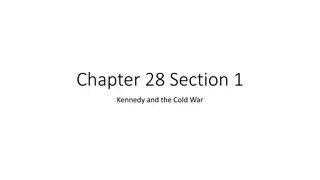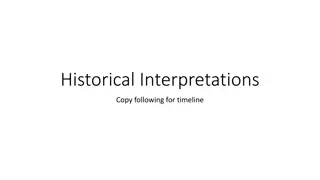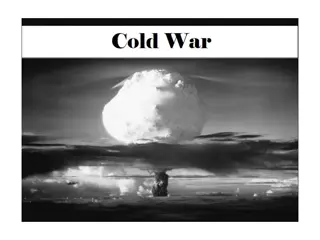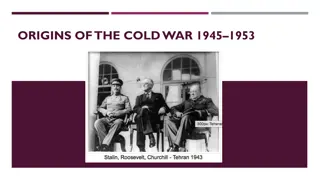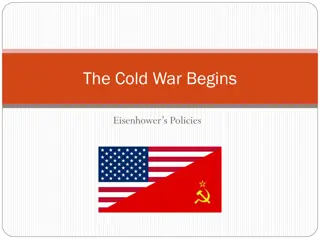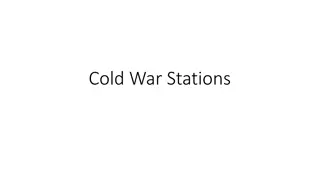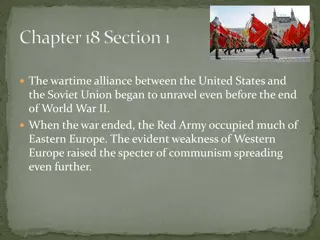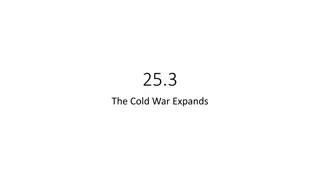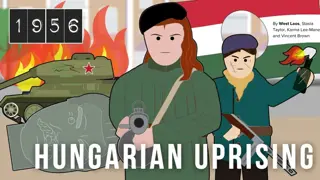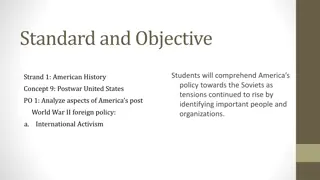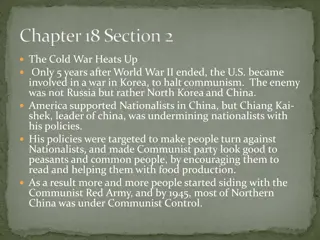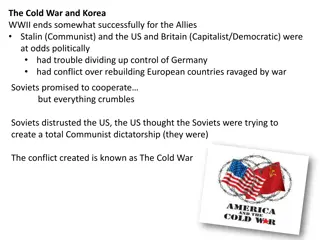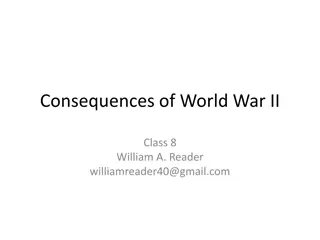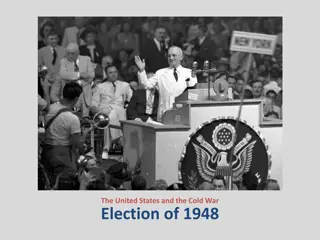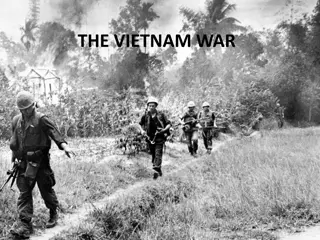The Cold War Begins: Early Years and Containment Policies
The early years of the Cold War marked by conflicts between the United States and the Soviet Union, shaped by policies like the Long Telegram, Containment, Truman Doctrine, and the Marshall Plan. Tensions escalated with events such as the Crisis in Iran and the Berlin Crisis as the world grappled with containing communism and rebuilding post-war Europe.
Download Presentation

Please find below an Image/Link to download the presentation.
The content on the website is provided AS IS for your information and personal use only. It may not be sold, licensed, or shared on other websites without obtaining consent from the author.If you encounter any issues during the download, it is possible that the publisher has removed the file from their server.
You are allowed to download the files provided on this website for personal or commercial use, subject to the condition that they are used lawfully. All files are the property of their respective owners.
The content on the website is provided AS IS for your information and personal use only. It may not be sold, licensed, or shared on other websites without obtaining consent from the author.
E N D
Presentation Transcript
The Cold War Begins The Early Cold War Years
Learning Targets: Describe the Long Telegram and its influence on American foreign policy. Give examples of conflicts between the United States and the Soviet Union during the early years of the Cold War. Take a position on whether or not you agree with Truman s handling of General MacArthur.
Containing Communism The Cold War shaped the politics and economics around the World Despite growing tensions, US officials believed it was possible to have cooperation with the Soviet Union. The Soviet Union refused to allow free elections in Eastern Europe The Long Telegram: George Kennan wrote this 5,540 word cable message explaining his perception of Soviet goals. Kennan explained that the USSR was afraid of the West and was prepared to engage in a long-term struggle against capitalism This information gave rise to the policy of Containment: Keeping communism within its current boundaries through diplomatic, economic, and military actions
Containing Communism Crisis in Iran. During WWII, Soviet and American troops occupied Iran to secure the region. After WWII, American troops withdrew, but Soviet troops did not and Stalin demanded access to Iran s oil supplies. The United States demanded that Soviet troops withdraw and sent in the battleship USS Missouri into the Eastern Mediterranean Sea. The Soviets withdrew with an agreement for an Iranian/Soviet joint oil company. The Iranian parliament later rejected the plan.
Containing Communism The Truman Doctrine: Next, the USSR tried to control a major water route in Turkey known as the straits of Dardanelles Truman chose to find out if the Soviets were bent on World conquest. Truman sent the aircraft carrier Franklin D. Roosevelt to assist the USS Missouri Great Britain was struggling to keep a communist backed guerilla war in Greece from taking over the Greek government These events led Truman to adopt a new policy know as the Truman Doctrine: A pledge that the United States would fight communism worldwide
Containing Communism The Marshall Plan: George C. Marshall proposed the European Recovery Program, or Marshall Plan, which would give European nations American aid to rebuild their economies. Both the Marshall Plan and the Truman Doctrine were seen as essential for containment
The Berlin Crisis Truman believed Western Europe s prosperity depended on Germany s economic recovery. Stalin still wanted to receive war reparations from Germany which would not allow Germany s economy to recover. West Germany is Founded: Without Soviet cooperation the US, Great Britain, and France announced the unification of their German territories to form the country of West Germany (democratic). West Germany s economy was completely separate from the Soviet zone The Soviets made their zone East Berlin (communist) West Berlin is Founded: Like all of Germany, Berlin had been divided into zones Berlin was located in the Soviet zone! A West and East Berlin were created inside communist East Germany
. .
The Berlin Airlift In late June 1948, Soviet troops blockaded (cut off all road and rail traffic) West Berlin (located in East Germany). Truman sent long range bombers with atomic weapons to bases in Britain. Truman also ordered that food, fuel, medicine, and other supplies for those living in West Berlin be airlifted in and garbage be airlifted out. 11 months later, Stalin ended the blockade. The Berlin Airlift became a symbol of American determinism to contain communism.
NATO (North Atlantic Treaty Organization) A group of democratic countries, including the United States, that agreed to come to each other s aid if any one of them were attacked. Soviet leaders responded by creating the Warsaw Pact: a group of communist countries that agreed to come to each other s aid if any one of them was attacked.
The Cold War Spreads to East Asia Civil War and Revolution in China In China, communist forces led by Mao Zedong had been struggling against the Nationalist government (which the US helped in WWII) led by Chiang Kai-shek. The US sent the Nationalists $2 billion in aid but it was wasted The Nationalists fled mainland China for Taiwan. Communism prevailed in China and the People s Republic of China was formed in 1949 as a communist government.
The Cold War Spreads to East Asia After the Fall China s fall to communism shocked Americans In September 1949, the USSR tested its first atomic weapon In 1950, China and the USSR signed a treaty of alliance The US kept formal diplomatic relations with only the Taiwanese Nationalists The US used its veto power to keep representatives of the new Communist China out of the UN allowing the Nationalists to retain their seats The US quickened its recovery plan for Japan just as the US saw Germany as a key to economic recovery and stopping the spread of communism in Europe, the U.S. saw Japan as the same for Asia.
The Korean War At the end of WWII, American and Soviet forces entered Korea to disarm the Japanese troops stationed there. The Allies divided the Korea at the 38thparallel of latitude. Soviet troops controlled the north,. American troops controlled the south. As the Cold War began, talks to unify Korea broke down. Governments in the north and south developed backed by the Soviets and the US The Soviets provided extensive military aid to North Korea who quickly built up a large army.
The Korean War On June 25, 1950 North Korean troops invaded into the South rapidly driving back the poorly equipped South Korean forces. The UN Intervenes Truman ordered United States naval and airpower into action. Truman also called on the United Nations to act. Normally, the Soviet Union would have vetoed any UN action against N.Korea Because the Soviet delegate had boycotted the Security Council over its China policy, the USSR could not veto any action by the UN against N.Korea The UN pledged troops and Truman ordered MacArthur to take troops out of Japan and send them to aid South Korea MacArthur made a daring invasion behind enemy lines at Inchon taking the North Koreans by surprise and driving North Korean troops all the way back to China at the Yalu River.
The Korean War China Enters the War The Communist Chinese saw UN troops as a threat and warned against North Korean troops being pushed into China China launched a counterattack when warnings were ignored and pushed UN troops back behind the 38thparallel MacArthur demanded the war be expanded to fight against China, including the blockade of Chinese ports, the use of Chiang Kai-shek s Nationalist forces, and the bombing of Chinese cities with atomic weapons.
The Korean War Truman Fires MacArthur President Truman refused MacArthur s demands because he did not want to expand the war into China or use atomic weapons MacArthur spoke out publicly against Truman Truman fired MacArthur and replaced him with General Matthew Ridgeway in 1951
The Korean War Changes in Policy The fighting between North and South Korea turned into a stalemate Peace talks started in 1951 and ended in an armistice in 1953 More than 33,600 American troops died in Korea Before the Korean War, The US used mostly economic aid to contain communism. The US was mainly concerned with containing communism in Europe After the Korean War, The US began a major military build-up to contain communism. The US became concerned with containing communism in Asia
Essay Question Tension between the United States and the Soviet Union began to increase after World War II because the two nations had different goals. Complete the diagram below. Then use it to help you discuss the different concerns and beliefs that contributed to the Cold War.
Essay Question Tension between the United States and the Soviet Union began to increase after World War II because the two nations had different goals. Complete the diagram below. Then use it to help you discuss the different concerns and beliefs that contributed to the Cold War. Soviet Union s Main Concern: Security Soviet Union s Ideology: communism United State s Main Concern: The economy United State s Ideology: democracy (or free enterprise) As the war ended, Soviet leaders became concerned about security. Germany had invaded Russia twice in less than 30 years. The Soviets did not want it to happen again. They wanted to keep Germany weak and make sure that the countries between Germany and the Soviet Union were under soviet control. The Soviet leaders also believed that communism was superior and would eventually replace capitalism, and that they should encourage communism in other nations. They also accepted Lenin s theory that capitalism causes ward and would try to destroy communism. American leaders believed that the Depression had caused World War II. It helped Hitler rise to power and caused Japan to seek to expansion to get the resources it needed. American leaders believed that economic growth was the key to world peace, and that increasing world trade would promote growth. For similar reasons, American leaders wanted to promote democracy, believing that it was the best way to stability and prosperity.
Essay Question In what ways did the Korean War mark a turning point in the Cold War?
Essay Question In what ways did the Korean War mark a turning point in the Cold War? The Korean War had convinced Eisenhower that the United States could not contain communism by fighting a series of small wars. Instead, these wars had to be prevented form happening in the first place. The best way to do that seemed to be to threaten to use nuclear weapons if a Communist state tried to seize territory by force. This policy came to be called massive retaliation. Brinkmanship was the willingness to go to the brink of war to force the other side to back down. Eisenhower used these two concepts in international confrontations. In Korea, for example he quietly let the Chinese know that the United States might continue the Korean War under circumstances of our own choosing. The message was a hint at nuclear attack. The threat to go to the brink of nuclear war seemed to work because negotiators soon signed an armistice.



